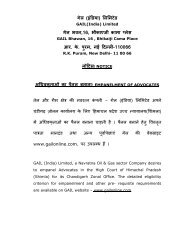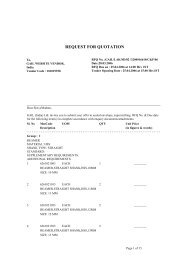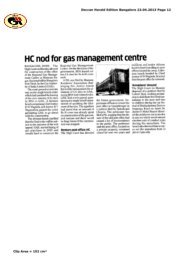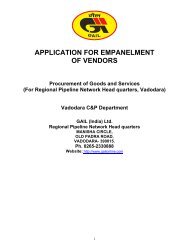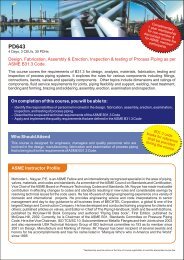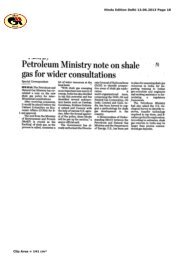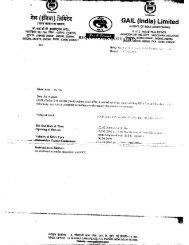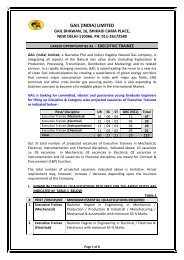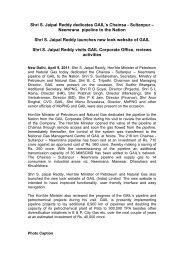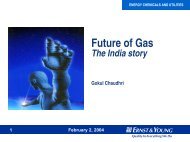Development of Cng Infrastructure in India with ... - GAIL (India)
Development of Cng Infrastructure in India with ... - GAIL (India)
Development of Cng Infrastructure in India with ... - GAIL (India)
Create successful ePaper yourself
Turn your PDF publications into a flip-book with our unique Google optimized e-Paper software.
<strong>Development</strong> <strong>of</strong> <strong>Cng</strong> <strong>Infrastructure</strong> <strong>in</strong> <strong>India</strong> <strong>with</strong> SpecialReference to National CapitalTerritory <strong>of</strong> DelhiSh. A.K. DeIndraprastha Gas Limited1. Concern for Pollution:After Independence <strong>of</strong> <strong>India</strong>, Delhi, the capital became major centre <strong>of</strong>commerce, <strong>in</strong>dustry and education. Rapid growth <strong>of</strong> Delhi resulted <strong>in</strong>significant <strong>in</strong>crease <strong>in</strong> environmental pollution. Based on the ambient airquality monitored by the Central Pollution Control Board <strong>in</strong> 1998, it wasfound that the contribution from vehicles to the ambient air pollution <strong>of</strong>Delhi was about 65% <strong>of</strong> total air pollution. This could be understood fromthe fact that vehicle population <strong>in</strong>creased from a number <strong>of</strong> 2,35,000 <strong>in</strong>1975 to 21,00,000 <strong>in</strong> 1991 and further to around 37,00,000 vehicles by 1 stJanuary 2004 <strong>in</strong> Delhi. The sector-wise emission <strong>of</strong> pollutants <strong>in</strong> Delhi canbe seen from the Table.SECTOR-WISE EMISSIONS* IN DELHI(Metric Tonnes per Day)POLLUTANTS TRANSPORT POWER INDUSTRY DOMESTIC TOTALUHC 310 2 6 2 320SPM 13 50 60 12 135NITROGEN OXIDES 157 143 20 3 323SULPHUR DIOXIDE 11 121 35 12 179CARBON MONOXIDE 810 8 128 117 1063TOTAL 1301 324 249 146 2020*Source: Central Pollution Control Board (CPCB), 19981
The above situation had given dubious dist<strong>in</strong>ction to Delhi as one <strong>of</strong> themost polluted city <strong>of</strong> the world.With the <strong>in</strong>creas<strong>in</strong>g number <strong>of</strong> pollutants <strong>in</strong> Delhi’s air and <strong>with</strong> thebackground <strong>of</strong> <strong>in</strong>creas<strong>in</strong>g trend <strong>in</strong> the use <strong>of</strong> CNG <strong>in</strong> the other parts <strong>of</strong> theworld, Public Interest Litigation (PIL) was filed <strong>in</strong> the Hon’ble SupremeCourt <strong>of</strong> <strong>India</strong> <strong>in</strong> 1985 seek<strong>in</strong>g <strong>in</strong>tervention <strong>in</strong> this matter. The Hon’bleSupreme Court had directed the Government <strong>of</strong> <strong>India</strong> to take <strong>in</strong>itiative <strong>in</strong>promot<strong>in</strong>g the use <strong>of</strong> CNG, an established clean fuel <strong>in</strong> the world astransport fuel <strong>in</strong> Delhi to control the <strong>in</strong>creas<strong>in</strong>g levels <strong>of</strong> ambient airpollution.2. What is CNG? Properties <strong>of</strong> Natural Gas:CNG is the short form <strong>of</strong> Compressed Natural Gas. The Natural Gas hasless energy density as compared to Liquid Fuel and hence it iscompressed to over 200 Kg/cm² (g) pressure to make it CNG for use <strong>in</strong> theautomobile sector. In its natural form it is colourless, odourless, non-toxicand non-carc<strong>in</strong>ogenic. However, this natural gas is mixed <strong>with</strong> an odorantto add flavour similar to the odour <strong>of</strong> LPG from a domestic cyl<strong>in</strong>der so asto facilitate detection <strong>of</strong> its leakage. The typical composition and physicalproperties <strong>of</strong> CNG (i.e. Compressed Natural Gas) is as follows:Typical Composition:Methane : 88%Ethane : 5%Propane : 1%CO 2 : 5%Others : 1%____Total : 100%Physical Properties :Non-toxic –Lighter than air –Natural gas be<strong>in</strong>g lead/sulphur free, its use substantiallyreduces harmful eng<strong>in</strong>e emissions. When natural gasburns completely, it gives out carbon dioxide andwater vapour - the very components we give out whilebreath<strong>in</strong>g!Natural gas be<strong>in</strong>g lighter than air, will rise aboveground level and disperse <strong>in</strong> the atmosphere, <strong>in</strong> thecase <strong>of</strong> a leakage.2
Colourless –Odourless –Natural Gas is available <strong>in</strong> the gaseous state, and iscolourless.The gas <strong>in</strong> its natural form is odourless, however, ethylmercaptan is later added as odorant so as to detect itsleakage.3. Pilot project <strong>of</strong> <strong>GAIL</strong> :• Objective: A pilot project was <strong>in</strong>itiated by <strong>GAIL</strong> (<strong>India</strong>) Ltd. <strong>in</strong> collaboration<strong>with</strong> <strong>India</strong>n Institute <strong>of</strong> Petroleum, Dehradun to establish the feasibility <strong>of</strong>us<strong>in</strong>g CNG as an alternative to liquid fuels such as Diesel & Petrol used bybuses & automobiles <strong>in</strong> 3 cities namely Delhi, Mumbai & Baroda.POLLUTION REDUCTION IN CNG FUELLED VEHICLESThe use <strong>of</strong> CNG <strong>in</strong> vehicles has lead to considerable reduction <strong>in</strong> air pollution asis evident from the follow<strong>in</strong>g data:A. Autorickshaw – Three wheelers:(Emission <strong>in</strong> gram/Km)Bajaj Three wheeler Pollutants Petrol CNG % ReductionHC 3.26 1.26 63.19CO 5.48 1.57 71.35CO2 47.44 27.60 41.82NOx 0.25 0.20 20.00Source: Bajaj Auto, the manufacturer <strong>of</strong> three wheelersB. Passenger Cars:(Emission <strong>in</strong> gram/Km)Pollutants Petrol CNG % ReductionMaruti Omni CO 19.79 .55 97HC 1.14 1.02 11Maruti Gypsy CO 4.94 0.59 88HC 1.86 1.42 24Premier Padm<strong>in</strong>i CO 18.38 0.94 95HC 2.83 2.03 28Premier 118NE CO 15.6 2.04 87HC 2.57 1.92 25Ambassador CO 52.16 0.78 98HC 6.37 4.33 32Source: Emission tests conducted by <strong>GAIL</strong> (<strong>India</strong>) Ltd., one <strong>of</strong> the promoter companies<strong>of</strong> IGL and the supplier <strong>of</strong> Natural Gas3
C. Diesel Buses:(Emission <strong>in</strong> gram/KWH)Pollutants Diesel CNG % ReductionAshok Leyland HC 1.68 1.4 16.67CO 4.5 3.77 19.37NOx 13.73 8.0 41.77ParticulateMatter* In gm / kmSource: Ashok Leyland, the manufacturer <strong>of</strong> buses0.125* 0.0029* 97.68• <strong>Infrastructure</strong> <strong>of</strong> <strong>GAIL</strong> under pilot project: 1 Mother station was<strong>in</strong>itially put up at Ghaziabad which has s<strong>in</strong>ce been shifted to SaraiKale Khan. This mother station was feed<strong>in</strong>g to 5 daughter stations <strong>in</strong>Delhi. 3 Nos. onl<strong>in</strong>e stations were added mak<strong>in</strong>g total 9 Nos. <strong>of</strong> CNGstations dur<strong>in</strong>g the pilot phase <strong>of</strong> the project. The station design andsafety norms followed were as per New Zealand standards.4. Formation <strong>of</strong> IGL:• Supreme Court gave directive to <strong>GAIL</strong> <strong>in</strong> July’1998 to expand theCNG <strong>in</strong>frastructure and to <strong>in</strong>crease the number <strong>of</strong> CNG stationsfrom 9 to 80 by March 31, 2000 <strong>in</strong> Delhi. It also directed Delhi Govt.to convert entire city bus fleet, autos & taxies from liquid fuel toCNG/Clean Fuel.• Subsequently <strong>in</strong> Dec.1998 Indraprastha Gas Limited (IGL) was<strong>in</strong>corporated as a jo<strong>in</strong>t venture company <strong>of</strong> <strong>GAIL</strong>, BPCL & Govt. <strong>of</strong>NCT <strong>of</strong> Delhi to implement the orders <strong>of</strong> Hon’ble Supreme Court <strong>with</strong>regard to the CNG expansion program <strong>in</strong> Delhi.• Issues <strong>of</strong> land allotment: Govt. <strong>of</strong> NCT <strong>of</strong> Delhi hold<strong>in</strong>g 5% equity <strong>in</strong>IGL helped IGL <strong>in</strong> gett<strong>in</strong>g the allotment <strong>of</strong> lands, permissions forlay<strong>in</strong>g pipel<strong>in</strong>es and <strong>in</strong> gett<strong>in</strong>g electricity connections.• Uncerta<strong>in</strong>ty on vehicles conversion: While IGL was formed to <strong>in</strong>stall80 CNG stations there was an apprehension whether the DTC buseswould be available for CNG usage. Besides all the autorikshaws,taxis and private buses were also to be converted for CNG use.Tremendous efforts were required to conv<strong>in</strong>ce DTC, Bus Operators4
and Delhi Adm<strong>in</strong>istration for the conversion <strong>of</strong> vehicles to CNG <strong>in</strong>such a short time. Today there are more than 87,000 vehicles <strong>in</strong> theNCT <strong>of</strong> Delhi, which are runn<strong>in</strong>g on CNG.5. Type <strong>of</strong> CNG Stations:Four types <strong>of</strong> CNG stations have been developed <strong>in</strong> Delhi. These are asfollows:Mother Station: Mother stations are connected to the pipel<strong>in</strong>e and havehigh compression capacity. These stations supply CNG to both vehiclesand daughter stations (through mobile cascades). Typically they have thefacility <strong>of</strong> fill<strong>in</strong>g all types <strong>of</strong> vehicles – buses/autos/cars. The Mother stationrequires heavy <strong>in</strong>vestment towards compressor, dispensers, cascades,pipel<strong>in</strong>es, tub<strong>in</strong>g etc.TYPICAL CNG MOTHER STATIONOnl<strong>in</strong>e Station: CNG vehicle storage cyl<strong>in</strong>ders need to be filled at apressure <strong>of</strong> 200 bars. “On l<strong>in</strong>e Stations” are equipped <strong>with</strong> a compressor<strong>of</strong> relatively small capacity, which compresses low pressure pipel<strong>in</strong>e gasto the pressure <strong>of</strong> 250 bar for dispens<strong>in</strong>g CNG to the vehicle cyl<strong>in</strong>der. The<strong>in</strong>vestment <strong>in</strong> an onl<strong>in</strong>e station is midway between daughter station andmother station.5
Daughter Station: The “Daughter Stations” dispense CNG us<strong>in</strong>g mobilecascades. These mobile cascades at daughter stations are replacedwhen pressure falls and pressure depleted mobile cascade is refilled atthe “Mother Station”. The <strong>in</strong>vestment <strong>in</strong> a daughter station is least amongall types <strong>of</strong> CNG stations.There is reduction <strong>in</strong> storage pressure at daughter stations <strong>with</strong> eachsuccessive fill<strong>in</strong>g. Once the storage pressure drops, the refuel<strong>in</strong>g time<strong>in</strong>creases, while the quantity <strong>of</strong> CNG dispensed to vehicle also decreases.Daughter-Booster Station: Install<strong>in</strong>g a booster compressor can elim<strong>in</strong>atedrawbacks <strong>of</strong> daughter stations. The mobile cascade can be connectedto the dispens<strong>in</strong>g system through a booster. Daughter booster(compressor) is designed to take variable suction pressure and dischargeat constant pressure <strong>of</strong> 200 bars to the vehicle be<strong>in</strong>g filled <strong>with</strong> CNG. The<strong>in</strong>vestment <strong>in</strong> daughter booster station is slightly higher than that <strong>of</strong>daughter station.TYPICAL DAUGHTER BOOSTER STATION6. Mega CNG Stations:Mega CNG stations have been conceptualized to cater to a large fleet <strong>of</strong>vehicles, particularly the buses. The objective is to provide comfortablefill<strong>in</strong>g experience to the consumers when they come to the station forrefuel<strong>in</strong>g. Mega CNG stations are constructed on much larger plot <strong>of</strong> land6
than that <strong>of</strong> conventional CNG stations, as a result <strong>of</strong> which more number<strong>of</strong> Compressors and Dispensers can be <strong>in</strong>stalled and more number <strong>of</strong>vehicles can be simultaneously refuelled at such stations. A Mega CNGstation has been commissioned at Roh<strong>in</strong>i, Sector 23 on July 13, 2003 and asimilar station has been put <strong>in</strong>to operation at Patparganj on June 30, 2003.At present, there are three Mega CNG stations <strong>in</strong> Delhi.The CNG Mega station at Patpargang has been constructed at a cost <strong>of</strong>around Rs.13.5 crores (USD 3 MM) to simultaneously refuel five buses andeight other vehicles (cars, autos, m<strong>in</strong>i buses etc.). Built on a plot <strong>of</strong> size 75m X 40 m, it has the capacity to comfortably refuel CNG to 800 buses andover 1500 other vehicles daily.7. Performance:The growth <strong>in</strong> the CNG <strong>in</strong>frastructure and the performance <strong>of</strong> IGL s<strong>in</strong>ce it’s<strong>in</strong>ception <strong>in</strong> December, 1998 is presented <strong>in</strong> the follow<strong>in</strong>g bar charts:Growth <strong>in</strong> CNG vehicles:800007000060000500004000030000200001000002 1000 2 181645492257529550434147000887470249April-98 April-99 April-00 April-01 April-02 April-03BusesOther Vehicles* Source: Transport Department, Government <strong>of</strong> Delhi.• Other Vehicles <strong>in</strong>clude private cars, taxis, three wheelers, m<strong>in</strong>i buses.• As on December, 2003 the number <strong>of</strong> vehicles is 87026. ( Buses 9958, others 77068)7
Growth <strong>in</strong> CNG Sales10.750.5660.76MILLIONKG/DAY0.50.2500.00830.0480.2671999-20002000-20012001-20022002-2003YEARS* upto 31-12-04* 2003-2004*Geographical Distribution <strong>of</strong> CNG stations(As <strong>of</strong> 01 st January 2004)Stations East West North South Central TotalDelhi Delhi Delhi Delhi DelhiMother - IGL 2 10 8 14 3 37Mother – DTC 2 8 3 5 1 19Onl<strong>in</strong>e 3 2 4 10 6 25Daughter 1 1 0 2 2 6Daughter 7 2 4 10 7 30BoosterTotal 15 23 19 41 19 1178
8. Economics <strong>of</strong> CNGThe growth <strong>of</strong> CNG vehicles <strong>in</strong> the year 2002 was primarily because <strong>of</strong>economic advantage <strong>of</strong> CNG <strong>with</strong> regard to petrol / diesel. Theeconomics <strong>of</strong> runn<strong>in</strong>g the CNG vehicles vis-à-vis its operation on petrol /diesel has been worked out at the current price <strong>of</strong> fuel. The results arereproduced <strong>in</strong> the form <strong>of</strong> the follow<strong>in</strong>g bar graph:65.6454.8Rs./km432100.481.27THREEWHEELER0.79 0.890.36 0.812.11CAR1.31.480.6BUS0.84BUS: DIESEL: 3.50 KM/LTCNG: 3.50 KM/KGCAR: PETROL: 15 KM/LTCNG: 21 KM/KGLPG: 13.5 KM/LTAUTO: PETROL: 25 KM/LTCNG: 35 KM/KGLPG: 22.5 KM/LTCNGPETROL / DIESELSAVING (w.r.t. Petrol/Diesel)LPGSAVING (w.r.t. LPG)CNG : 16.83 Rs/Kg PETROL : 33.70 Rs/Lt. DIESEL : 20.73 Rs/Lt.LPG: 20.04 Rs/Lt9
9. Cities where City Gas Distribution Projects be<strong>in</strong>g planned :As per the directive <strong>of</strong> the Hon’ble Supreme Court <strong>of</strong> <strong>India</strong> dated April 5,2002, <strong>in</strong> order to control heavy air pollution due to vehicular traffic, thefollow<strong>in</strong>g cities <strong>in</strong> <strong>India</strong> have been identified for develop<strong>in</strong>g <strong>in</strong>frastructurefor distribution <strong>of</strong> alternative fuel:KanpurAgraFaridabadPatnaVaranasiJodhpurJhariaHowever, the study <strong>of</strong> air pollution <strong>in</strong>dicated that the pollution <strong>in</strong> the cities<strong>of</strong> Jodhpur and Jharia is ma<strong>in</strong>ly due to dust pollution than vehicularemissions. Also, there are no trunk gas pipel<strong>in</strong>e <strong>in</strong> the vic<strong>in</strong>ity <strong>of</strong> Patna andVaranasi.Subsequently, <strong>in</strong> August 2003, Hon’ble Supreme Court <strong>of</strong> <strong>India</strong> has issued adirective to the Union <strong>of</strong> <strong>India</strong> and the state governments to draw plans to<strong>in</strong>troduce clean fuels <strong>in</strong> 11 cities apart from the exist<strong>in</strong>g cities <strong>of</strong> Delhi andMumbai. These are:KolkataChennaiBangaloreHyderabadAhmedabadSholapurSuratLucknowKanpurAgraPuneUnder its Project Blue Sky, <strong>GAIL</strong> has already drawn plans to implement citygas projects <strong>in</strong> the five cities <strong>of</strong> Kanpur, Lucknow, Agra, Bareilly and Pune<strong>in</strong> phases at an estimated <strong>in</strong>vestment <strong>of</strong> Rs. 554 crores (equivalent to 118Million USD).10
CNG STATIONS IN INDIA AS ON JANUARY 1, 2004StationTypeDelhi Maha.IGL MGLVadodara<strong>GAIL</strong>SuratGGCL/GSPCGujaratAnkleshwarGGCLTotalGrandTotalMother 56 3 1 1 0 2 61Onl<strong>in</strong>e 25 46 0 2 0 2 73DaughterBooster30 15 0 0 0 0 45Daughter 6 0 1 0 1 2 8TOTAL 117 64 2 3 1 6 18711
ItemDelhiMumbaiIGL MGLVadodara<strong>GAIL</strong>GujaratSuratGGCL /GSPCAnkleshwarGGCLTotalGrandTotalNo. <strong>of</strong> vehiclesCars 15876 47870 450 663 123 1236 64982Autos 56846 61497 16 429 0 445 118788RTV/LCV 5164 7 0 0 0 0 5171Buses 10075 47 0 0 0 0 10122TOTAL 87961 109421 466 1092 123 1681 199063Average Consumption - -TPD 760.00 382.30 0.57 3.00 0.30 - -MMSCMD 1.18050 0.54280 0.00073 0.00300 0.00030 - -The total no. <strong>of</strong> CNG stations planned to be operational by the end <strong>of</strong>f<strong>in</strong>ancial year 2003 – 2004 would be as follows:-1) Delhi : 1202) Mumbai, Maharashtra : 883) Gujarat : 612
10. Difficulties For Develop<strong>in</strong>g CNG <strong>Infrastructure</strong>The follow<strong>in</strong>g difficulties are faced <strong>in</strong> develop<strong>in</strong>g CNG <strong>in</strong>frastructure:• Limited natural gas allocation lead<strong>in</strong>g to delay <strong>in</strong> management decisions onexpenditure commitment• Uncerta<strong>in</strong>ty about conversion <strong>of</strong> vehicles & CNG demand• Lack <strong>of</strong> <strong>in</strong>digenous technology• Capital <strong>in</strong>tensive project - a mother station cost would be 5-6 times thecost <strong>of</strong> a petrol pump & pipel<strong>in</strong>e need to be <strong>in</strong> place• Infrastructural constra<strong>in</strong>ts (Electricity, land etc.)• Delay <strong>in</strong> gett<strong>in</strong>g permissions from statutory authorities• Objection from local people, encroachment• Low storage capacity <strong>of</strong> on board cyl<strong>in</strong>ders, thus requir<strong>in</strong>g frequent refills11. Factors Influenc<strong>in</strong>g the Success <strong>of</strong> CNG Project:• Government commitment to the program• Susta<strong>in</strong>able economic advantage over liquid fuels• Appropriate CNG technologies• Appropriate program management• OEM support• Safety <strong>of</strong> CNG vehicles and CNG economic are key factors thatdeterm<strong>in</strong>e the success <strong>of</strong> CNG program12. Environment and Climate ProtectionIn <strong>India</strong> a new Auto Fuel Policy has been adopted <strong>in</strong> October’03 and thepolicy gives a roadmap for achiev<strong>in</strong>g various vehicular emission normsover a period <strong>of</strong> time and the correspond<strong>in</strong>g fuel quality up gradationrequirements. While it does not recommend any particular fuel ortechnology for achiev<strong>in</strong>g the desired emission norms, it suggests, tak<strong>in</strong>g<strong>in</strong>to account security <strong>of</strong> supplies and exist<strong>in</strong>g logistics, perspectives, thatliquid fuels should rema<strong>in</strong> as ma<strong>in</strong> auto fuel through out the country andthat the use <strong>of</strong> CNG/LPG be encouraged. The report also recommendsmeasures for improv<strong>in</strong>g the present mechanism <strong>of</strong> check<strong>in</strong>g pollution form<strong>in</strong> used vehicles.13
The roadmap for vehicular ignition norm for new vehicles would be asfollows:CoverageEntire Country11 Major cities(Delhi/NCR,Mumbai, Kolkata,Chennai,Bangalore,Hyderabad,Ahmedabad,Pune, Surat,Kanpur & AgraCars, LCVs & HeavyDuty Diesel vehiclesBharat Stage II:1.4.2005Euro III Equivalent:1.4.2010BharatStageII:1.4.2003Euro III Equivalent:1.4.2005Euro IV Equivalent:1.4.20102/3 WheelersBharat StageII:1.4.2005Bharat Stage III:Preferably from1.4.2008 but not laterthan 1.4.201013. Lessons Learnt <strong>in</strong> Implement<strong>in</strong>g CNG ProgramIGL <strong>in</strong> a short span <strong>of</strong> five years has <strong>in</strong>stalled 117 CNG stations <strong>in</strong> NCT <strong>of</strong>Delhi <strong>in</strong> spite <strong>of</strong> various hurdles faced dur<strong>in</strong>g implementation <strong>of</strong> theprogram. The follow<strong>in</strong>g lessons have been learnt <strong>in</strong> implement<strong>in</strong>g theCNG <strong>in</strong>frastructure development program:• Study <strong>of</strong> geographical spread <strong>of</strong> CNG vehicles movement is a must toanalyze the peak demand at <strong>in</strong>dividual CNG stations• Pipel<strong>in</strong>e distribution <strong>in</strong>frastructure needs to be <strong>in</strong> place• Dedicated/adequate mobile cascade fill<strong>in</strong>g arrangement cont<strong>in</strong>uoussupply <strong>of</strong> gas to daughter stations.• Involvement <strong>of</strong> local government/transport authorities• Genu<strong>in</strong>e cyl<strong>in</strong>der kits and spare parts be used for CNG vehicles toavoid accidents• Suitable codes/standards are to be <strong>in</strong> placed for CNG kit fitment,test<strong>in</strong>g etc.• Safety and performance standards should be <strong>in</strong> place, monitored andenforced14
• CNG stations need to be built <strong>in</strong> large open space to allow multivehicle and multi po<strong>in</strong>t dispens<strong>in</strong>g• <strong>Development</strong> <strong>of</strong> CNG <strong>in</strong>frastructure needs to be <strong>in</strong> l<strong>in</strong>e <strong>with</strong> growth <strong>of</strong>CNG vehicles.• Long term advance plann<strong>in</strong>g needs to be carried out• <strong>Development</strong> <strong>of</strong> CNG station is time and d capital consum<strong>in</strong>g activity.14. ConclusionCompressed Natural Gas has been accepted as an alternative fuel bythe public at large. The stage is set for expand<strong>in</strong>g the network to othercities. The success <strong>of</strong> CNG Expansion Program would depend on manyfactors. The key factors be<strong>in</strong>g the economy <strong>of</strong> CNG vis-à-vis otherconventional fuels, adherence to safety guidel<strong>in</strong>es and the GovernmentSupport.Auto LPG is also launched on a large scale <strong>in</strong> the country. At the end <strong>of</strong>the day, it will be the quality <strong>of</strong> the fuel and economics which would beimportant parameters for the commercial success <strong>of</strong> auto fuel. Theemphasis would be on fuels <strong>with</strong> lowest emissions. However, CNG is herefor the time be<strong>in</strong>g till a better fuel is discovered <strong>of</strong>fer<strong>in</strong>g better economicsto the users.15




